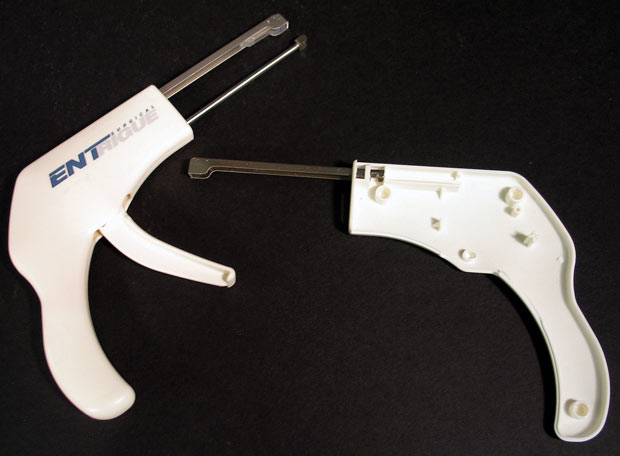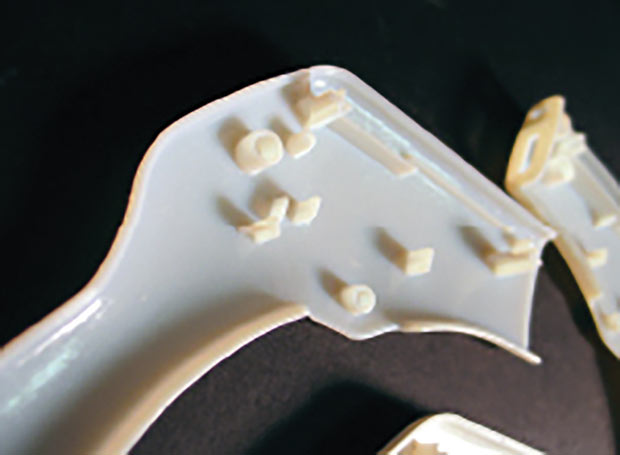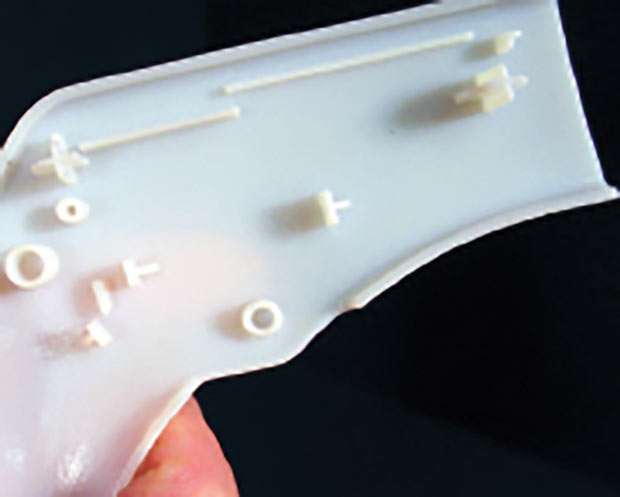
Typical example of a system used for arthroscopic surgery. Image courtesy of Arch Day Design/Stratasys.
Latest News
May 1, 2016
Arch Day Design is a comprehensive medical device design firm specializing in minimally invasive devices. The firm is based in Ventura, California, and its principals have more than 25 years experience. Its clients range from individual surgeons to large health care companies such as Allergan.
 In the past, Arch Day Design outsourced prototypes to service bureaus. Image courtesy of Arch Day Design/Stratasys.
In the past, Arch Day Design outsourced prototypes to service bureaus. Image courtesy of Arch Day Design/Stratasys.Prototypes are used in the medical device design process to check everything from form, fit and function to manufacturability. These prototypes often have small, intricate parts that are difficult to produce. According to Tom Weisel, president of Arch Day Design, some parts are as small as a staple and just 0.020 in. thick.
Time to market is critical in the highly competitive medical device space, so speed is essential to the design process. The ability to quickly produce highly accurate prototypes improves competitiveness. Shaving a few days or weeks off the design process can often mean the difference between being first or second to market.
For years, Arch Day Design outsourced rapid prototyping work to service bureaus, spending tens of thousands of dollars a year. The quality of the parts was generally good, but Weisel was unhappy with the cost and turnaround time, which was usually at least three days.
“We knew that with an in -house system we could turn around prototypes much more quickly and probably reduce our overall costs,” Weisel said. “But the initial purchase price scared us away.” Then a colleague recommended the Objet30 ProTM 3D Printer. The Objet30 Pro 3D printer is a compact office-friendly system that produces high-quality, finely detailed printed models. It can be used to create smooth surfaces, complex geometries, small moving elements, fine details, standout text and whatever else a design demands.
Objet30 Pro Provides High Value and Quality
“In the past, everything we’d seen was too expensive, had poor quality finish or just wasn’t accurate enough,” Weisel said. “The Objet30 Pro is the first 3D printer within our budget that produces high-quality parts suitable for medical device work. It can handle 99% of our prototyping needs.”
 With its Objet30 Pro 3D printer, Arch Day Design can sometimes produce a design and prototype in one day. Image courtesy of Arch Day Design/Stratasys.
With its Objet30 Pro 3D printer, Arch Day Design can sometimes produce a design and prototype in one day. Image courtesy of Arch Day Design/Stratasys.“With our Objet30 Pro 3D printer, we have cut prototype iteration cycles from three days to just three hours, depending on the part design,” Weisel added. “We have tripled the number of design iterations and still get to design freeze more quickly, which shortens our customers’ time to market.”
The Arch Day Design team has found the Objet30 Pro particularly helpful for handles and mating parts. “We design a lot of handles,” explains Weisel. “There’s no real magic to it, except that they have to feel good in someone’s hand. The feel of a handle can’t be determined on a CAD screen. When we outsourced prototyping there wasn’t time to try many alternatives. The Objet 3D Printer makes it possible to try a lot of different options to see which one feels best.”
Mating parts are tricky, according to Weisel. His team can now do multiple iterations to make sure they get the right click-lock. “The alternative of having the parts molded takes far too long,” he said. “With the Objet 3D printer, we can do two or three sets of parts in one day and get to a great design fast.”
“The ability to create more design iterations enables us to improve the product,” Weisel explained. “Instead of guessing, we can print out all the options and take a closer look. We can try several different approaches and evaluate them objectively. Having an in-house printer also frees us to try some edgy designs that we might not try if we were limited to evaluating CAD designs or had to skip prototyping due to time or budget constraints. These designs will ultimately become parts that are used in real people, so every last detail is absolutely critical.”
Fast Prototyping Leads to Breakthrough
For example, recently Arch Day Design was working on a new design for an arthroscopic cannula system for a client and had access to a surgeon-advisor just once per month.
 Typical example of a system used for arthroscopic surgery. Image courtesy of Arch Day Design/Stratasys.
Typical example of a system used for arthroscopic surgery. Image courtesy of Arch Day Design/Stratasys.A cannula is a guide tube used for arthroscopic surgery. The client’s previous design, comprised of three parts, had strength and reliability issues. Just two days before meeting with the surgeon, the Arch Day team conceived of a one-piece cannula design that would require surgeons to slightly change the way they performed a certain procedure. No one knew if the surgeon-advisor would see the change as minor or not.
“In just one day, we were able to design the new part and print out prototypes for the upcoming meeting,” Weisel said. “The surgeon thought the new design was a major improvement and said that the procedure change it would require would be inconsequential. If we hadn’t had the ability to produce that prototype in a day we never could have pitched that concept.”
In another example, during a regular Monday morning update meeting with a client, an idea for a design enhancement for a critical part came up. However, the molder was already fabricating the tool and the production deadline was looming. But the idea was too good to pass up.
“We printed the part on our Objet30 3D Printer within a couple of hours,” Weisel said. “After doing some bench testing, we transferred a revised drawing to the molder that same afternoon. The change was implemented with no delay to the mold delivery, hence no delay to the overall schedule. Our client was amazed.”
On several occasions, says Weisel, Arch Day Design has had customers call in the morning and say, “I have an idea.” With their Objet30 3D printer, the team is able to turn around the design and a prototype that same day. “Time is money, now more so than ever,” says Weisel. “It’s a huge advantage for us to be able to turn things around that quickly. Every day we save on design saves the customer a day in getting their product to market.”
On a related note, Arch Day Design frequently gets calls from customers who need parts printed quickly for internal design review meetings, testing or focus groups. “Before we had the Objet30, we needed three or four days to produce a prototype,” Weisel said. “That meant sometimes we had to tell customers that we couldn’t make their deadline. Now, we can help them out even with just a few hours notice. There’s no substitute for putting a real prototype in a surgeon’s hand.”
In-House Prototyping Increases Business
As a result, Weisel notes that Arch Day Design is getting more business from existing customers. “They are outsourcing more design work to us and asking us for more prototypes,” he said. “In the past, some customers had us do initial designs but not the prototype work. So we’re earning a greater share of their business.”
More Info:
Subscribe to our FREE magazine, FREE email newsletters or both!
Latest News
About the Author
DE’s editors contribute news and new product announcements to Digital Engineering.
Press releases may be sent to them via [email protected].






